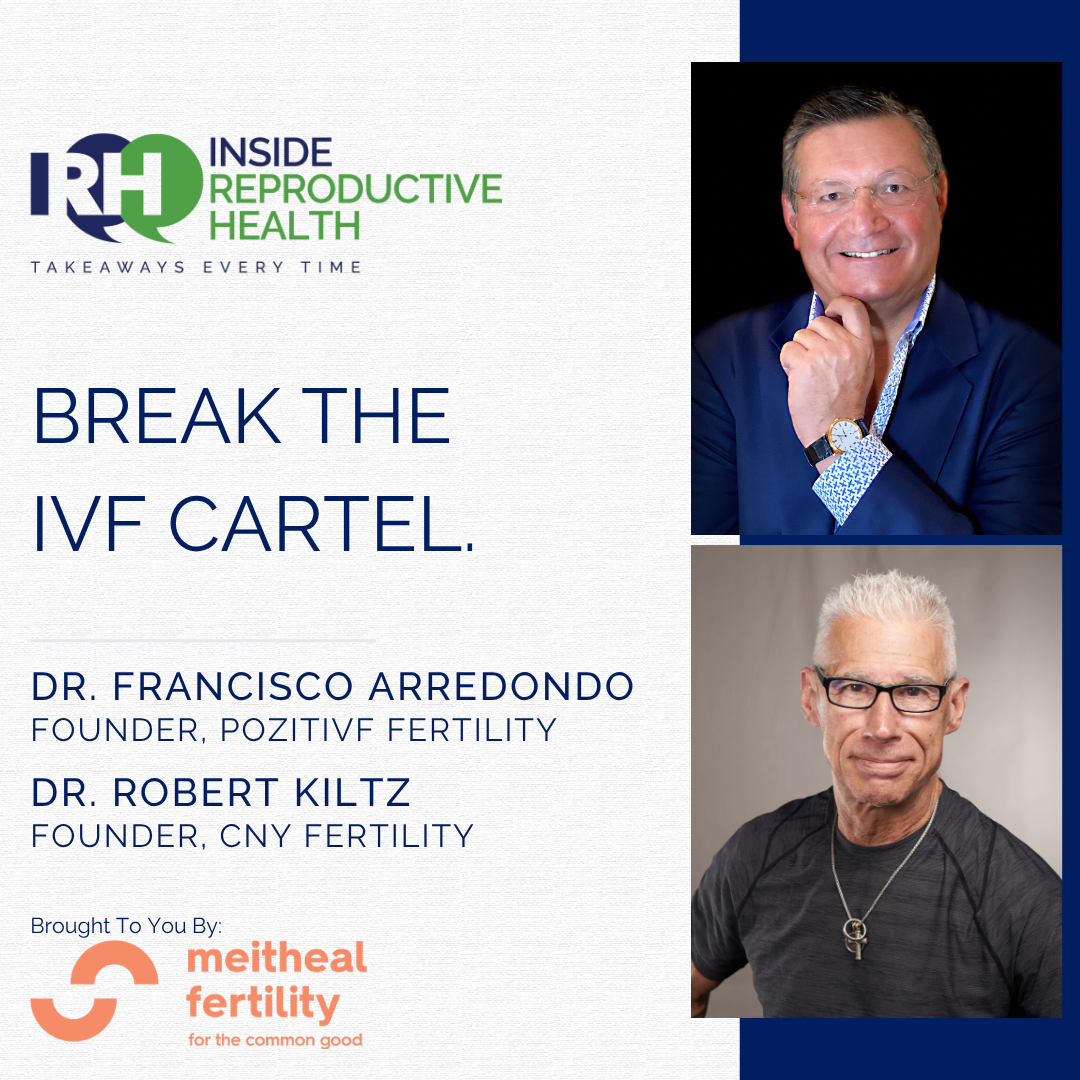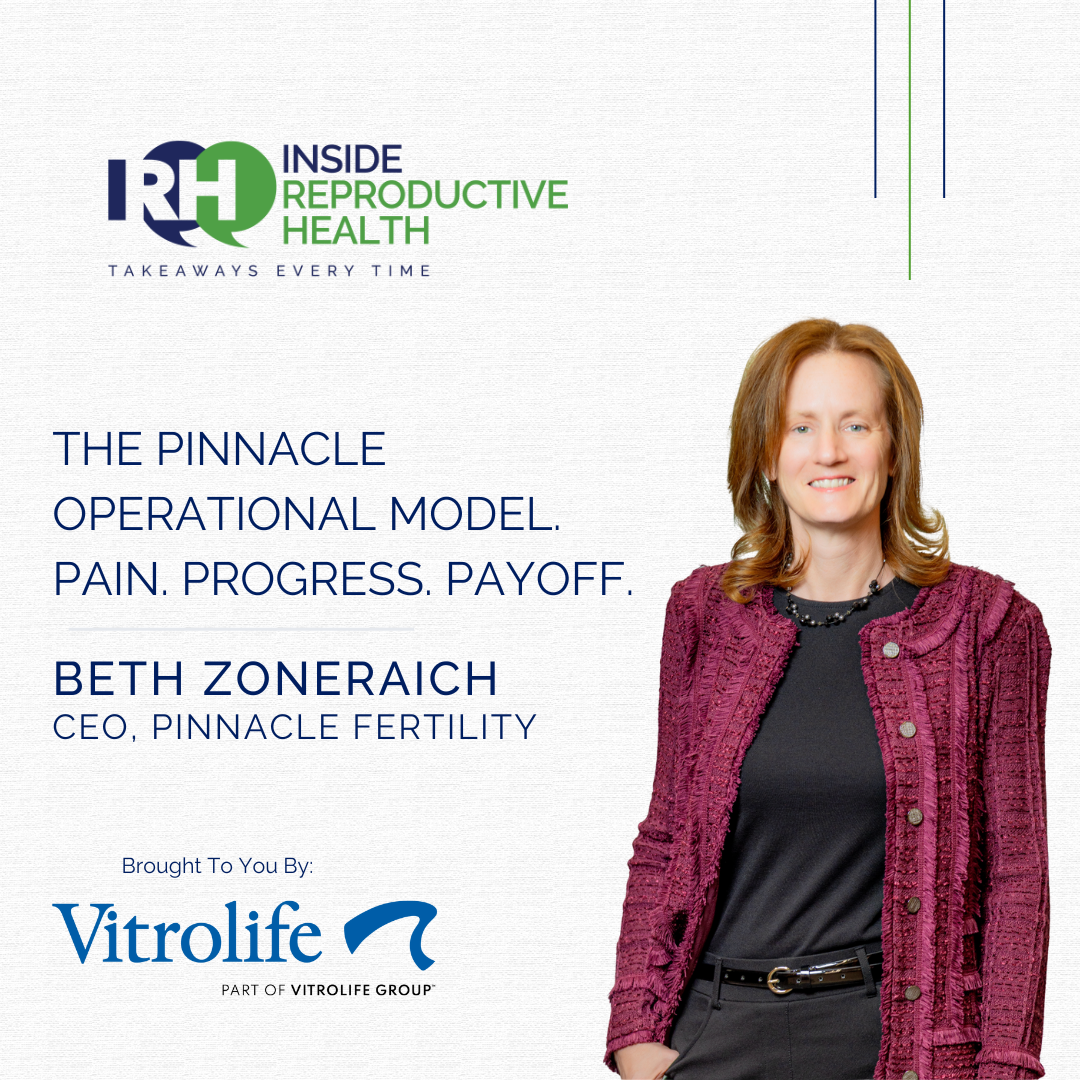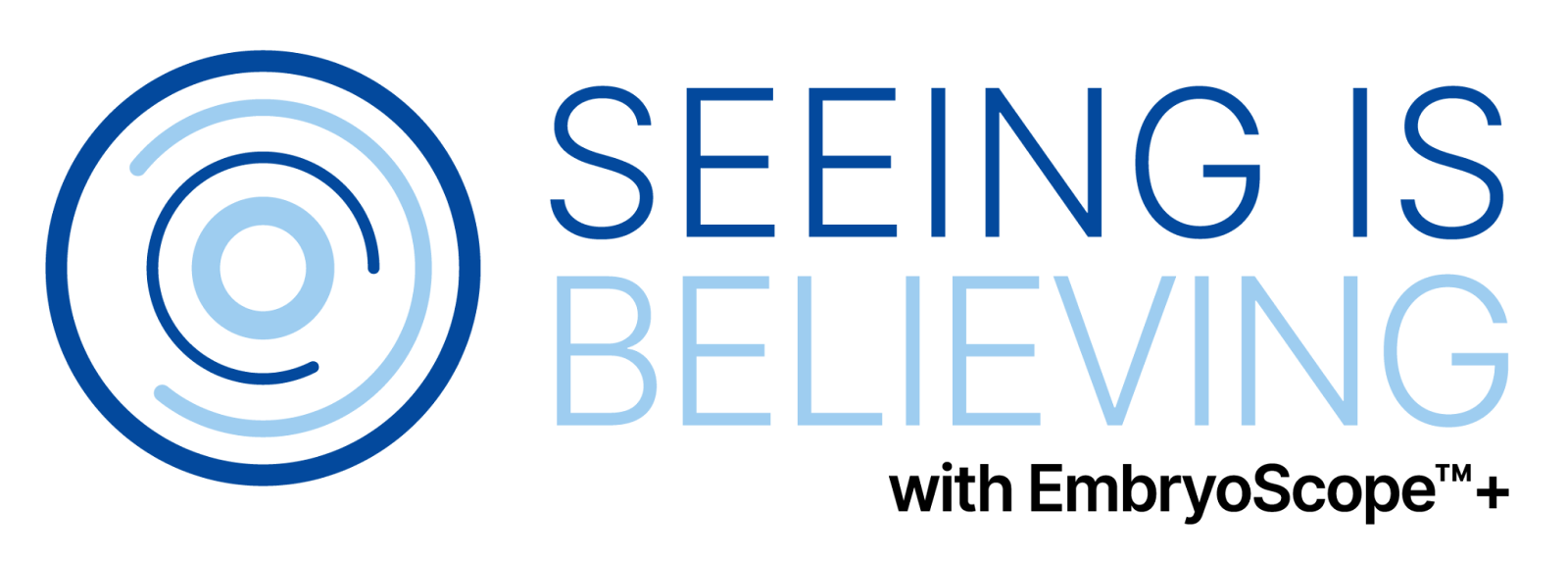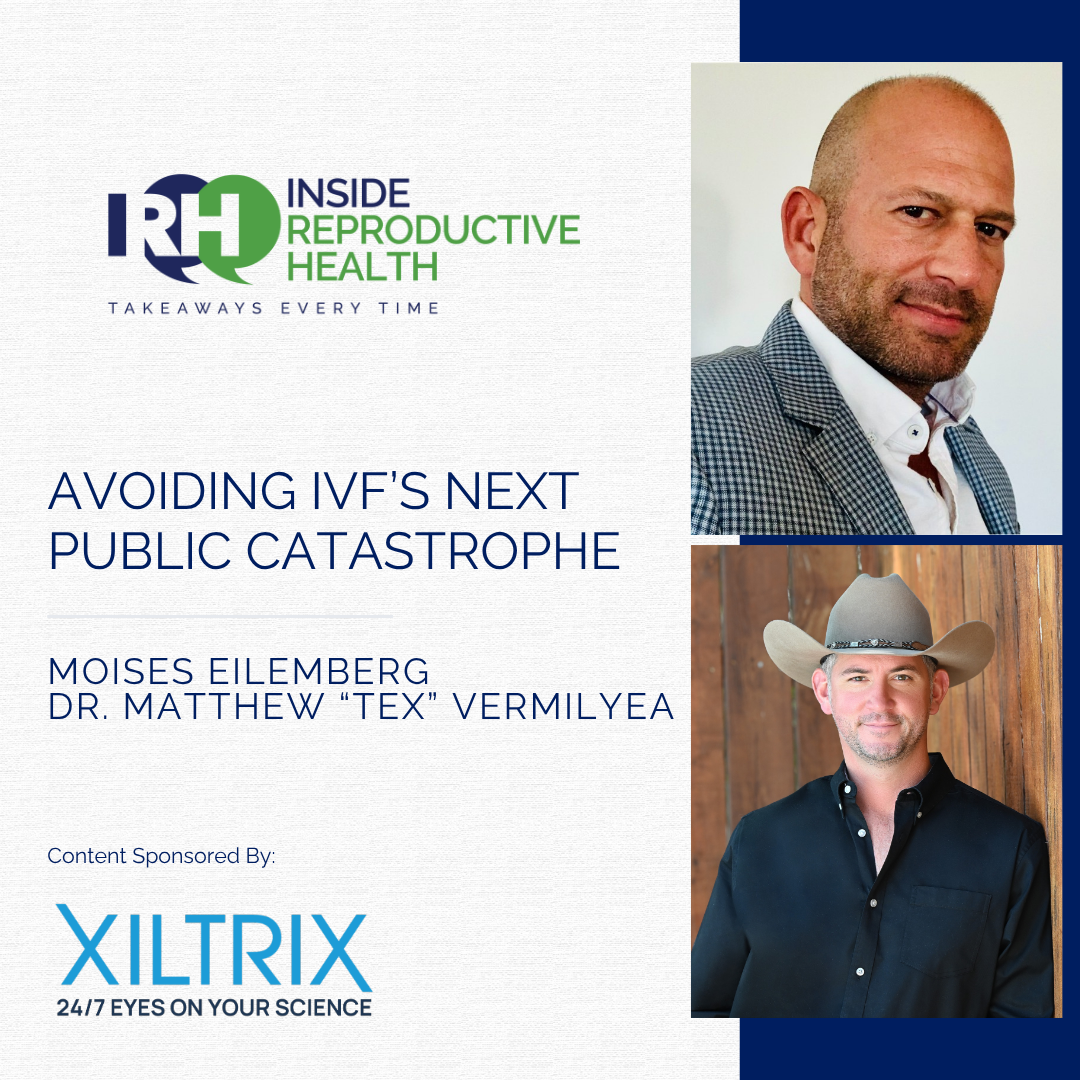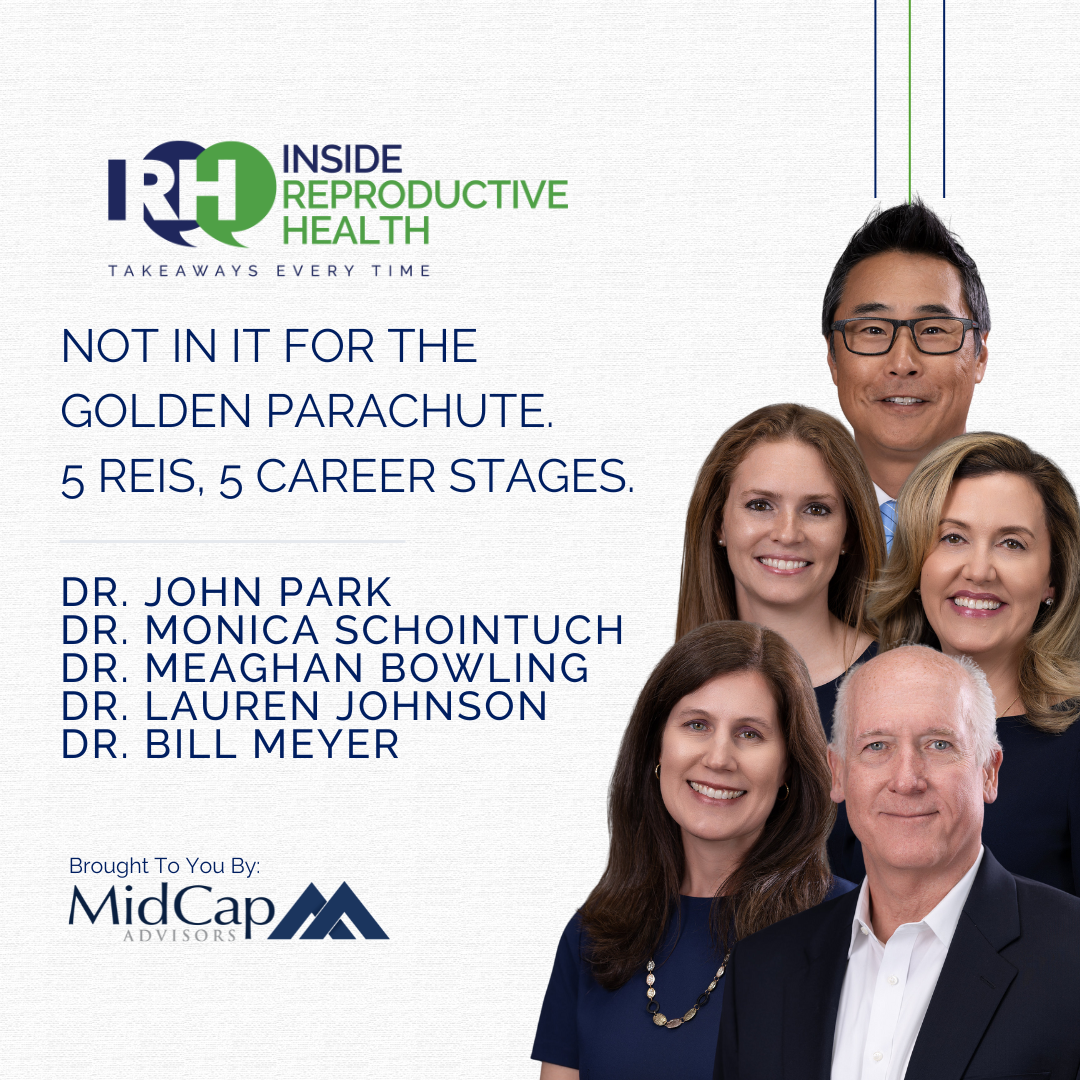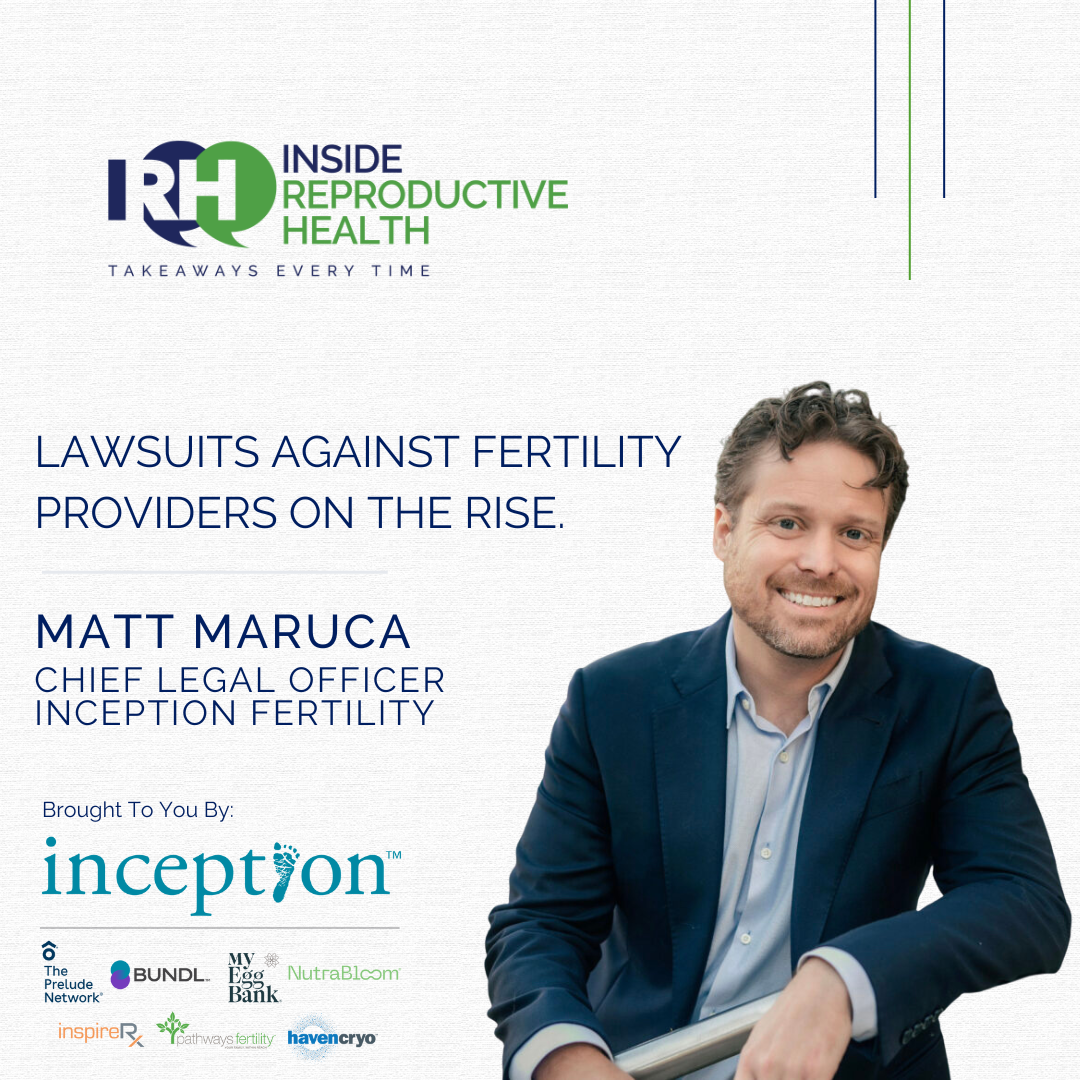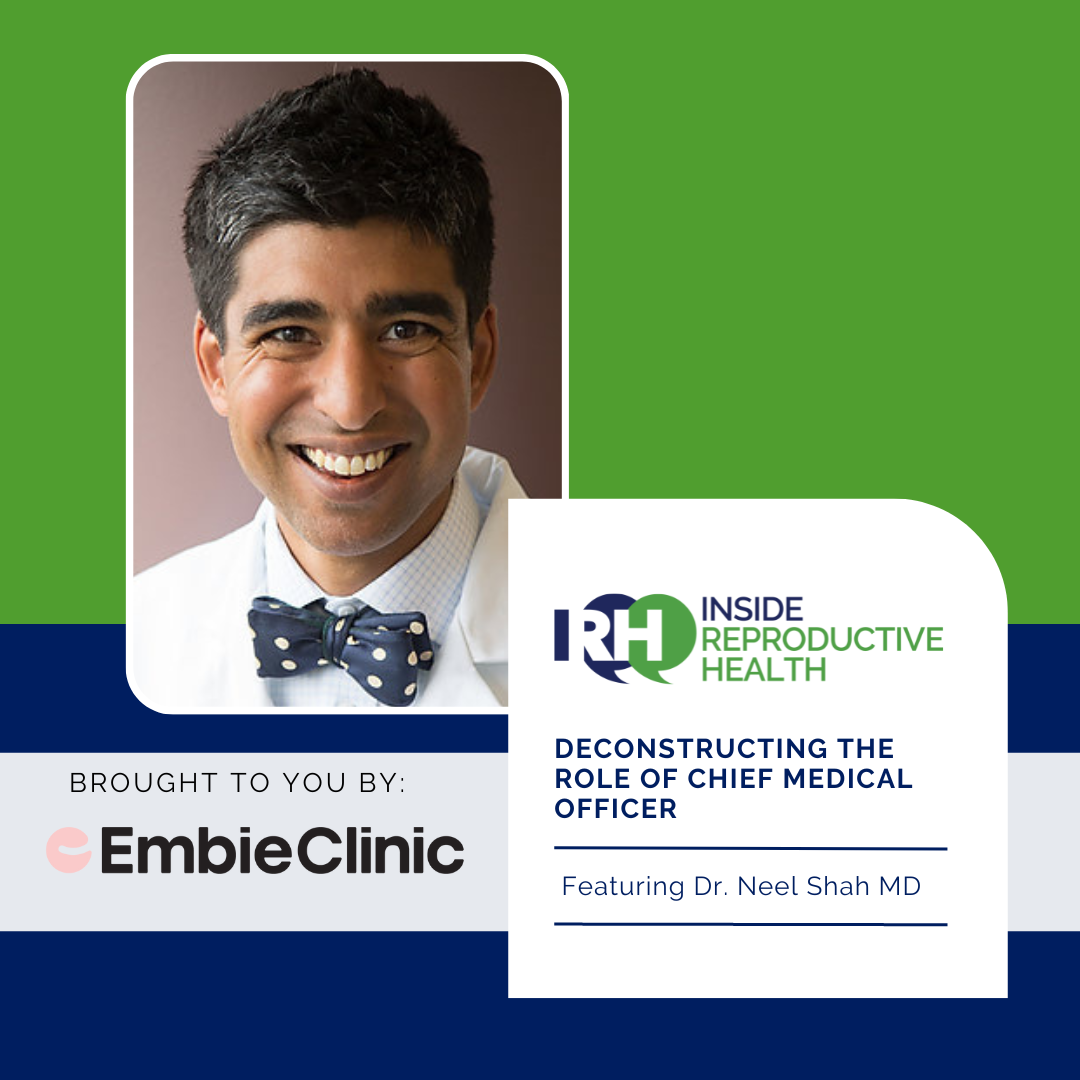Today’s Advertiser helped make the production and delivery of this episode possible. But the themes expressed by the guests do not necessarily reflect the views of Inside Reproductive Health, nor of the Advertiser. The Advertiser does not have editorial control over the content of this episode, nor does the Advertiser's sponsorship constitute an endorsement of the guest or their organization. The guest's appearance is not an endorsement of the Advertiser.
What’s the definition of a cartel, and has the way we pay for care created one in fertility?
This week on Inside Reproductive Health, two practice-owning REIs with very different models join Griffin to push that question hard. Dr. Robert Kiltz (CNY Fertility) and Dr. Francisco Arredondo (Pozitvf IVF & The IVF Academy) dig into the economics, the ethics, and the possible alternatives to the status quo.
They discuss:
Dr. Arredondo’s argument that today’s IVF system resembles a cartel (and what can be done about it)
The right question to ask about access and cost in IVF
How insurance helped create today’s medical-industrial complex
Dr. Kiltz’s meeting with HHS leadership and what it revealed
Lessons from Aravind Eye Care in India (Could that model work for IVF?)
What the IVF Academy is teaching clinicians about entrepreneurship and sustainable practice
This episode doesn’t offer easy answers. It’s a clear-eyed conversation about structural incentives, mission, and what it will take to make IVF more affordable and accessible.
STOP LOSING IVF PATIENTS TO COST & STRESS!
Meitheal Fertility’s Affordable, Generic Medications Keep Patients in Treatment & Boost IVF Conversions
Are your patients dropping out due to high costs and emotional stress? You’re not alone. The biggest hurdle in IVF isn’t just medical—it’s financial and psychological. Now, Meitheal Fertility offers a solution.
✔ Lower costs with high-quality, generic fertility medications
✔ Reduce patient dropout and increase conversions
✔ Boost patient satisfaction with affordable alternatives
✔ Expand revenue streams by unlocking a new market sector
Discover the Solution Now – Learn about our current medications including Ganirelix and Cetrorelix as well as our product pipeline. Help more patients start and complete their IVF journey.
-
Paco Arredondo (00:00)
You know, what is the official definition in the dictionary of a cartel? An association of manufacturers or suppliers with the purpose of maintaining prices at a high level and restricting competition. Okay. And nobody in our industry intentionally believes that because when we went to medical school, we went to medical school to do good, to help other people. What incentive does it makes for us to go and try to make something a lower price. Number one is because it's the right thing to do.
Griffin Jones (00:40)
What's the definition of a cartel? How did insurance create the current medical industrial complex? Can not-for-profits make IVF more affordable? My guests are two REIs, two practice owners in different parts of the country that are two of the leaders in providing and scaling affordable IVF. One's Dr. Robert Kiltz owner of the largest independently owned fertility center in the United States by volume, CNY Fertility, and Dr. Francisco Arredondo, founder of Pozitivf and the IVF Academy in Texas. They discuss...
What is the right question to begin with? They discuss the history of the insurance driven medical industrial complex. Dr. Kiltz is meeting with HHS Secretary Robert Kennedy's undersecretary.
Dr. Arredondo's visit to one of the largest providers of eye care on the planet, the Aravind Hospital in India, and how we can adapt that model to fertility care.
Dr. Kiltz' views on faith, money, and service. What they're teaching clinicians about business and entrepreneurship at the IVF Academy.
CNY Fertility converting to a not-for-profit as a part of Dr. Kiltz's legacy planning?
And Dr. Arredondo's take on IVF's current state as a cartel, even if unintentional, what can be done about it?
Dr Rob Kiltz (02:51)
I think if we can inspire more people to move into this space, that's the better because there's infinite opportunities to help more and more people.
whether it's IVF or IUI or nutrition or mindset, these are things that are important. But we know that IVF has a very powerful improvement in success for so many people. My mission at CNY Fertility is again, let's grow the pot.
here for more people to be able to do that even by simply talking online about these methods and inspiring people to join us.
Griffin Jones (03:32)
But that's not all you're doing, Robin. You are reaching hundreds of thousands, maybe even more people with your fireside chats, with your different social media. You are educating a lot of people. But you've also built an entire system to make IVF more affordable.
Paco Arredondo (03:47)
Yeah, I think.
Dr Rob Kiltz (03:47)
Well,
we're certainly doing that. And I know Paco is involved in this also, that we can do it by just doing it. This is this idea that we're trying to get the government. I recently went to a visit with Dr. Fink, Undersecretary in the HHS under Kennedy. And they're not looking to suddenly, you know.
make a bill that IVF is going to be covered for everyone, the people have to do this. And that's what I went to say is, listen, we at CNY Fertility are diligently involved in how can we help people get pregnant naturally first? And then if they need assistance, how can we make it more accessible and affordable? We need to be doing that together.
Paco Arredondo (04:32)
I could not agree more and ⁓ Rob is kind enough to mention me, but Rob has been doing this for a while and he has been certainly the leader in more ⁓ affordable and it's important to mention that affordable doesn't equal lower quality, it means higher value.
But what Joshua said, it's super basic. Number one, fertility should not be seen as a luxury. It is a human right. Number one. Number two, it's one of the most powerful preventive medicine tools. People don't get that IVF, is the most powerful preventive and cost effective preventive tool.
as good as vaccines, we can prevent billions of dollars utilizing PGTM to avoid genetic diseases. So no longer anybody should see this as a luxury. Having a healthy child should not give the wallet a heart attack. And
the importance that Rob and other people have been doing to try to make it more accessible, it goes under a very basic premise, which is what good is science if most people can't afford it? We've been, you know, we've been
When we began doing IBF in 1978, my first presence into IBF was in 1989. I was a medical student. Pregnancy rates were 5, 10%, 12%.
And actually, by the way, that's the reason why people compare IBF to IUI, because at that time, you know, sometimes I was even better. Right. But nowadays, we are in this activism that we are comparing to things right now. Let's don't fool ourselves. The most effective tool that we have is IBF. And we just need to make it more affordable now.
Going to what Rob mentioned about government interventions. Just give me one, two minutes. We have to get into this little rabbit hole that is important, which is health insurance. Everybody knows that IVF should be covered by health insurance and government mandate. It would be nice. You have to understand the history of health insurances.
Health insurances were nonexistent before World War II. They were not health insurance. So why health insurance appeared? Well, after post World War II, there were no workers. So how do we retain workers? What is the most catastrophic financial thing that they have? Health care. 80 % of them till this day that goes in people that go into bankruptcy go because health care issues. So
Dr Rob Kiltz (07:19)
Mm-hmm.
Paco Arredondo (07:21)
Healthcare insurance, so it was never created to control cost, was never created to improve quality, was always created just to prevent financial catastrophe. And in a way, health insurance is the underlying culprit of the medical industrial complex. And two, post-pandemia.
There's no workers again. Or let's give them health care insurance. everybody has health insurance. by the way, the people that we're going to try to attract is between 25 and 45. Fertility benefit managers. Both health insurance and fertility benefit managers is the right answer to the wrong question. The question they're trying to answer is.
How can we make more people to pay for IVF? How can we get more people to pay for healthcare? And that's the wrong question. The right question, which Rob has been trying to answer for a while and also a little bit more recently, is how can we make IVF affordable? Different question.
And when you ask the right question is you get the right answer. I don't know if you know this story about the two monks that were drinking and they were very, very good at drinking. And they go and says, you know what, we have to tell the bishop that we have to tell the bishop that when we drink, we are such more persuasive. We should he should let us drink and pray at the same time. Yeah, let's go and ask him the next day in the bar. The two priests get together and says,
Did you talk to him? Yes, me too. What did he tell you? He said, oh, he told me no. He says, what? He told me yes. What did you ask? He said, well, I asked him if we could actually drink while we pray. And he said, absolutely not. What did you ask him? He says, well, I asked him if.
we could pray while we drink. I said, anytime is good to pray. Absolutely, you can do it. So how we the industry has avoided the right question that I think Rob has been trying to answer for several years by now.
Griffin Jones (09:33)
By answering the right answer to the wrong question, is the contrapositive also true? In other words, are they giving the wrong answer to the right question? Are fertility benefits managers making or going to make fertility care more expensive, just like how the insurance industrial complex made many expensive?
Dr Rob Kiltz (09:57)
Well, let me back up just a little bit. We know that in general, the health of humans around the globe, and we're talking specifically in America, is getting worse and worse and worse. So we're getting sicker at younger ages, and the cost of healthcare goes up and up and up. And as Dr. Arredondo mentioned that the single leading
reason for bankruptcy absolutely is health care debt. And so I always want to step back and say, well, how can we help people be healthier and not even need us? Because that's number one. If we can help more people be healthy, and that's why I talk a lot about nutrition,
I talk a lot about faith and fasting and I talk a lot about paleo, keto and carnivore diets. Lots of different things you can do in all of this because the leading answer for what's the cause of disease is I don't know. And even as why is healthcare cost so much? The answer is I don't know. And I think really the answer
is let's help our brothers and sisters, absolutely our children's children's children, because I know Griffin, you just had children, you have young children. I am a granddad now, and I know how powerful this is, but the healthcare costs are rising and the incidence of disease, including infertility, and if you think about it, the canary in the coal mine is reproductive disorders.
And so we're seeing more and more canaries die in the coal mine, even though you can't smell it or see it or know it. Our job is to recognize that polycystic ovarian syndrome, endometriosis, pelvic inflammatory diseases, and male and female reproductive disorders are on the rise. The American College of Obigyuan recommends a plant-based diet primarily for
pregnant lactating women, but they also recommend red wine. So back to the priests, the monks asking for alcohol, we recommended ⁓ illogical diet, lifestyle that may be the biggest cause. So let's start there. And then, and I know Dr. Arredondo is working like myself to train nurse practitioners, physicians assistants.
and other doctors, not REI board certified specialists to provide the services that we need an army of people in order to reduce the cost. Limited numbers, the specialty stays special and the costs stay high.
We need to train every human being to understand nutrition and healthcare and how to be healthier themselves, take control of that, have the ability through Dr. Arundando's practice or my practice to get every test they want to understand why they're infertile and then how they can take their own healthcare in their own hands. And through the power of the people to bring the cost down because right now more and more people that aren't
not doctors are controlling health care. And so let's give the power to the people and help them understand it and invest in all sorts of health care themselves. And then making fertility care and specifically IVF more affordable and accessible by opening up to training more people and make it easier and more accessible and affordable for everyone.
Griffin Jones (13:40)
making note of those two buckets, there's the operational level of making fertility care more affordable, the APPs, nurses, OBGYNs, and the way you structure your practice, there's a societal level of preventative medicine, of education, of diet. And I want to come back to each of those. And maybe we will even in this conversation, but Paco is the flip side to what you were saying of answering the right answer to the wrong question is the flip side of that are the employer
managers making our ART more expensive or are they going to?
Paco Arredondo (14:13)
It would be
silly at this moment for me to criticize people that are trying to do what they believe is the right thing. And I think they're trying to, know, the healthcare industry when it started was a good, with good intention. Fertility benefit management is the good intention, but we're not addressing the root cause. Two things on what you said and what Rob mentioned to us. There are...
In medicine, there's three solid pillars, preventive, curative, and rehabilitation. And there is no question that the most cost effective of all the medicines is the preventive. I just made the argument that preventive genetic diseases will save billions of dollars, and we have the math to prove it. The same way that good lifestyle, good nutrition,
and all these will prevent. And if I can criticize our industry and our group of physicians and institutions is that we've done very little in the preventive and we know what are the preventive things for fertility. There's three or four. One, no smoking. Two, abnormal weight, up or down. Three.
The biological clock, in other words, once more, preventive medicine, freezing eggs. So all those are, and the fourth one is sexual transmitted diseases. Those are the four underlying culprits that we can have control as an individual in society to significantly reduce infertility. On the other side of what you mentioned,
is a lot of our colleagues are very afraid. I think it's, you know, the momentum is changing and I like that because, you know, at the beginning some people are criticizing and then, you know, first they ignore you then criticize you and then, you know, everybody wins. OB-GYNs, nurse practitioners, physician assistants will not, let me emphasize this, will not replace reproductive endocrinologist.
But reproductive endocrinologists that use OBGYNs, nurse practitioners, PAs, will replace the REs that will not use those people. Because it's impossible for the demand that we have to satisfy, with the supply that we have, to satisfy the demand that we have. So, you know,
instead of acting out of fear and scarcity we should think in abundance we can do this and who needs to make the rules is the REIs and if we don't do them somebody else will and like Rob said a lot of people that don't know anything about medicine and are making those decisions
Griffin Jones (17:07)
In reproductive medicine, we all know the leading cause of IVF cycle dropout isn't a lack of medical options, it's cost. High medication expenses create stress that pushes patients out of treatment and keeps conversion rates lower than they should be. Meitheal Fertility is working to change that with affordable
high quality generic medications like Ganarellix and Setrorellix. By lowering financial barriers, clinics see fewer treatment dropouts, higher completion rates, and improved overall outcomes. And it's not just better for patients, it also means stronger practice performance and expanded revenue opportunities. Meitheal Fertility is actively building a pipeline to broaden access to across fertility care. Learn more about their current portfolio and pipeline and what's next at
meithealfertility.com. A lot of the changes you guys are talking about at the operational level and the societal level seem like a lot of it can be a lot of work. And one of the reasons for doing all of that work might be, well, they're going to make IVF either insurance payer or mandated or government payers and really lower the margins. Therefore,
we've got to have something that's more efficient. so we've got to start working on the positive IVF models and the CNY fertility models because that's the only way it's going to be viable. To your point, Rob, if Kennedy's undersecretary at HHS is saying, yeah, we're probably not going to do that IVF mandate after all or anytime soon, then what's the impetus for making all these changes at the operational and society level? If somebody can just make
a really good living doing the way they've always done it.
Dr Rob Kiltz (18:51)
Well, I think the biggest problem has been the limited number of REIs, reproductive endocrinologist fertility specialists that are trained.
and they've cut back on the numbers over the years and the supply and demand, it's just the standard economic curve, right? If the supply of specialists is low, demand is high, the costs are higher. And we've been training gynecologists
nurse practitioner PAs for years and even nurses that become the specialists who doing IUIs and ultrasounds in the practice or helping manage much of the system that I think if you look at all other areas of health care
nurse practitioners and PAs are utilized tremendously doing many more ⁓ complicated procedures than we allow them to do in reproductive medicine to the point that I think our specialty is really coming hard out against it. But it's gonna be pushed back.
because of the needs and the costs. And the truth is everyone else is doing it. Why should our specialty be any different? the, we, our job at CNY, my job, I went into medicine not to make money. I went into medicine for a mission to help people. But what I found is that the mission seems to be more about profits than people.
And I want to maintain my purpose as a doctor is how do we help more people? And that's why I've integrated Eastern and Western ideas together, not to throw one out as good and one as bad.
but to bring them together, let me help you conceive naturally or become healthy naturally. And then at the same time, through the CNY fertility system where we're training internally.
And also with Dr. Arandondo's practice and Dr. Magarelli, who's been part of that for us in the past and I know through others and Pinnacle I think is working on training program. Kind Body has been doing that. It's good to see, but we need to bring them in. Right now.
Colorado and SRM or I don't know who else is involved. They're trying to stop a qualified physician assistant from doing what she's trained and qualified for. And we think that's wrong. And we're going to continue.
Griffin Jones (21:36)
Can
you tell me more about that? I'm not familiar with that.
Dr Rob Kiltz (21:38)
I think I'm going to leave it as my statement I've made. It's happening in our communities where we're trying to prevent doctors and even trying to prevent gynecologists who are duly trained. And in my case, my nurse practitioner or PA is far more experienced, has done more retrievals and transfers than the majority of REs out there. And a specialty from training programs.
And so our job is to train, qualify people that can do this under the proper training programs that we should be able to give power to more people to provide the care. And in our case, we're trying to lower the price even more. so we need to be, and what's happening is the community is pushing for this. And we want to make that happen through CNY fertility.
Paco Arredondo (22:30)
Yeah. A couple of points there. One is for those in our field that are very evidence-based, there is solid randomized controlled trials that embryo transfers by nurse practitioners are exactly as good as a fertility specialist. Several. Or better, for sure. So, evidence-based tells you that.
Dr Rob Kiltz (22:50)
or better, or better.
Paco Arredondo (22:56)
Number two, let's say that tomorrow with a magic wand, we make everybody able to pay for IVF. We don't have the people. We don't have the people. And partly not in an intentional bad effort. And I want to underlie that. It's not in a bad effort that one person or a couple of people done, but
You know, I hate to do this, but I will have to I'm going to say it because I've been trying to say it for a while. When I said this to a lot of people. People get angry at me. You know, what is the official definition in the dictionary of a cartel?
association of manufacturers or suppliers with the purpose of maintaining prices at a high level and restricting competition. Okay. And nobody in our industry intentionally believes that because when we went to medical school, we went to medical school to do good, to help other people. Let's get back to that group.
let's get back to the route that we are here to help others. And your original question Griffin was what incentive does it makes for us to go and give something or try to make something a lower price. Number one is because it's the right thing to do.
is the right thing to do. But number two, the reason is difficult. You're getting into the core of what the innovator's dilemma is. The innovator's dilemma, know, Toyota comes with the Corolla at a lower price and GM and forces. Should I go and defend that low cost or should I make more SUVs that have a much bigger margin of profit? That's what they did in Toyota.
kept that. And now Toyota is suffering exactly the same. Why should I go and defend that part with Kia and Hyundai when I can have the privilege of fighting with the Lexus, with the Mercedes-Benz and BMW? So the core of the innovator's dilemma is this. There's three types of innovations. One,
Sustaining innovation when you have a product and you make it better and better and better when you have IBF that it was a 10 % and now we are at 60 % That's sustaining innovation. But in a sense we as an industry we've been polishing the same Ferrari For 47 years the second type of innovation which Rob is an expert and the second to one of them is efficiencies
which entails everything that you mentioned, utilizing nurse practitioners, PAs, OBGYNs, making the things faster, do not use things that you don't need, do not upsell just because you want to upsell, be transparent. If somebody's the leader on transparency and putting all the prices in a website, here's my guy here on the left, which I can tell you that I copy that from him.
So is it transparency or having the prices out there? So that's the second, efficiency. And the third one is developing new markets, going after the non-consumers. So when patients, and I tell them our approach to other colleagues, my colleague says,
My patient will never tolerate not seeing me every day. My patient will not tolerate seeing a nurse practitioner. Yes, your patient. My patients in this sense now, they are grateful. Before, when I used to practice the boutique ⁓ IVF, people demanded my expertise. Now people take it as a gift. They are so grateful and they don't have that many demands.
So those are the three.
Griffin Jones (26:50)
You're saying because and Rob can speak to this. People are assuming that the alternative to not seeing the doctor every at every visit is seeing the doctor at every visit. But the alternative for the vast majority of people to not seeing the doctor at every visit is to see absolutely no one.
Paco Arredondo (27:07)
Mm-hmm.
Dr Rob Kiltz (27:09)
The world is changing. Our good friend at Sama Fertility, SARTech, who's spearheading home vaginal scanning. The testing world where it's all going to be home testing on your devices is growing. Home inseminations are growing.
with Josh Abrams work and creating the automated IVF laboratory of basically a robot that does tremendous amount of work. So you'll need fewer embryologists in the lab. That's coming. Healthcare controlled by the consumer is coming. It's already there in many ways. Many people are touting themselves as a ⁓ coach.
a medical coach, a fertility coach, they're giving information that used to be at the control of the doctor world. It's changing right now. And we either join it and be part of it to also participate in how we can make it easier and more accessible and affordable for people to have home care access.
And that's where I think is really big in the supplement world, the nutrition world, the meditation world, the sunlight therapy or red light therapy or acupuncture. So many of the things are expanding.
and are going to leave us behind unless we immerse ourselves in learning more about these things. We provide nutrition and acupuncture and all sorts of other modalities, but we also do strictly telehealth. We have our health care coaches that are available for our clients to get access in.
My nurses have been doing monitoring for 25 years with us and more so and you may be able to say, listen, I want to go to the boutique. Those should and will continue. But we're also at the same time saying, hey, listen, people say, I want you to to my ultrasound. I say, I don't do them. My nurses have more knowledge than 99 % of
Paco Arredondo (29:01)
It's fun.
Dr Rob Kiltz (29:15)
of well-trained and well-seasoned docs out there. Again, I always, you know, why did you get into medical school and someone else not? Is because you're smarter than them? More capable than them? It has nothing to do with that. The same thing with getting a fellowship. There are only so many slots. So what the world is doing with the new technology of these devices is giving people the access that nowadays,
our clients, our patients control what meds they want, when they want to trigger, how they want things to happen. And we're very open to all of that. And which I think, again, we're talking about making something accessible and affordable. It's going to happen without us and healthcare because you're talking about generic medications.
Our ability to get, mean, medication world, the pharmaceutical world is way too costly and it should be much less. Well, maybe we should look at more natural cycle IVFs, not even all these medications. You know, even when it comes to PGT testing, is it required or necessary? It's not. Again, the majority may be able to do something so simple where they're calling us and saying, you know, the system is going to be all AI, robotic.
They're gonna self schedule their retrieval. I mean, we're just gonna show up currently and retrieve the eggs. The robot's gonna help create the embryo. And our current method is a technician is gonna put the embryos in the uterus.
Paco Arredondo (30:48)
Yeah, when we talk about these three levels and the fear of competition. So every market has three levels, top, medium and low. Ritz Carlton, Four Seasons, Windham Holiday Inn Express, Motel 6. And you can go Ferrari, BMW, Mercedes, Toyota. Well, currently in our business,
Most of the practices in the affordability sections are risk-altering four seasons. The rest are homeless, not even a tent. Homeless. So if you, and even us, and I would say, I would argue even Dr. and myself, that we give ⁓ cycles at half or one third the price of other centers.
we are still not affordable. I'm going to give you one statistics. 2025, 59%, six out of 10 people in United States cannot afford a $1,000 surprising expense. Let me repeat that. 60 % of the people in the United States do not have $1,000 in the bank. Let that sink in because when I
discuss with colleagues and tell me, well, you know, it's only $2,000, $3,000 more. What are you talking about? We live in a bubble. What are you talking about? Most of the people can't afford that.
Dr Rob Kiltz (32:20)
Well, one of the things we've done is we've created self financing. We finance everyone. We don't do a credit check on anyone. we've done well over the years. People need some assistance and they have to postpone their payment for a little bit. That's worked out wonders for our system. And I think that we need to be making, I mean, the standard percentage,
for financing. mean they're charging 20 % for financing which is outrageous and you know we need to be doing it much better in our standard medical system and it would be nice and and and this is something we should let's create it. Craco is is ⁓ the society of affordable fertility care and and ⁓ invite others to be part of this to share the ways of doing it and and open up I invite
Paco Arredondo (33:11)
Not a happy day.
Dr Rob Kiltz (33:14)
Anyone wants to come visit my center, you know, Parker came. I have nothing to hide. And, and, ⁓ the more we open up to teach more people how to do it. That's the beauty.
Paco Arredondo (33:16)
here.
Yeah, so that's actually very consistent for us. You know, when we created positive, the vision was very clear. Number one, having a healthy child is a universal human right. We want to accomplish that vision with two missions. One, having as many clinics at more affordable rate.
and two, creating and sharing knowledge. And that's what we create the idea of Academy and everybody we don't train people only for us. We train people for everybody. So anybody it's open. But talking about, you know, dovetailing this to something that I was talking to Griffin before the we started is that in the efficiency levels and your model remind me. So I recently went to India to visit Aravind. Aravind is the largest
hospital in the world they do like three to four million cataracts a year you pay whatever you want and 50 % of them is free and on top of that every year they do 85 to 87 million in surplus
And they are actually a nonprofit. they just reinvented, they reinvested and they have created a new hospitals. But the way they did is by creating their own lenses, create their own this. Right now, the cost of medication is 40 % the cost of the whole IVF for you or 50. It's just ridiculous. And medication that has been in the market since 1960,
Dr Rob Kiltz (34:54)
We are creating a non-for-profit.
CNY Fertility is converting to a non-for-profit along with our parent company, Kiltz Health, with the pure intention of how to provide more care for more people at a lower price. And again, always instilling quality into that mix. We can do a lot better. And as you went to India, where I think they do many other types of practice of medicine,
and
more efficiently. We're very inefficient, our systems. can do much better in integrating AI and robotics, but we want people to go to work. People, that's the most important thing to me is helping more people provide the services and training, creating.
the academy, the university, and that's what we're really ⁓ focused on. I'm soon to turn 70 and it's like, well, what's going to happen when you're gone? I see it just keeps going. Just keeps going. We're here to do what God has gifted us to do. Help our brothers and sisters around the globe have a vibrant, healthy life and build families because, you know, that's really the foundation that so many people are suffering from.
postponing it or, you know, unnatural lifestyles, both what they put in their mind, in their mouths and how we're all living. We're going too fast. We've got to slow it down.
Griffin Jones (36:19)
For every fertility practice, the biggest hidden loss isn't clinical, it's financial. When patients abandon treatment because of high medication costs, you're not just losing cycles, you're losing revenue, efficiency and long term growth. Meitheal Fertility helps practices change that equation by offering affordable, high quality genetic generic medications like Ganarelex and Setorelex. They reduce patient drop off and keep more cycles moving forward.
that translates into higher conversion rates, more completed treatments, and a stronger bottom line for your clinic. Plus, with a growing product pipeline, Hall is positioning practices to capture a broader market and expand revenue streams without compromising quality. Don't let cost be the barrier that stalls both your patient's journeys and your practice's performance. Visit meithealfertility.com. That's meithealfertility.com.
to learn how to strengthen your business through affordability. did I hear you correctly that CNY is converting to a nonprofit?
I was talking with someone and don't ask me who it was because I honestly don't remember who it was and they were saying it like a compliment. But they almost kind of said it as a throwaway line and we were talking about models for affordable IVF and they're like, oh, then they're CNY but that's basically a nonprofit. whoever it was meant it as a compliment. But now you actually are becoming a nonprofit. Tell us about that.
Dr Rob Kiltz (37:47)
Well, the whole, let's see. So Kiltz is gonna die. And then everyone's like, what's gonna happen when he dies? Well, we're gonna divide it up and everyone's gonna, I said, who should get anything? Nobody. We're here for healthcare, help care. And I've always, that's been my life since I was a little kid. And so...
I've committed, I've sort of like, I've been working my brain on this. Everyone's like, what's gonna happen? We gotta do all this estates and trusts. And I'm like, like not for profit, just do it. And so we're working on, not for profit is for the profits of people, not for the cash in the bank, but the creation of our...
our brothers and sisters. That's why I am here and what I've gone into. I live a very good life. And that if we can give back to continue the mission so that it's not gonna be disabled and be thrown into the junk yard. Now, I always say when I'm dead, something will happen. But if we have some control,
of creating a non-for-profit of St. Jude's, of the Shriners, many other healthcare systems are doing that, that we are here where the profits are all put right back into the mission of what we're doing on both the pharmaceutical side, the surgical side, the nutritional side, you know, all the healthcare sides that we're putting into. That's what I'm committed to.
to doing before I go and that it continues when I'm gone.
Griffin Jones (39:25)
My impression, maybe I'm wrong about this, I don't know if it's fact based, but that the most sustainable type of organization is a profitable sole proprietorship or privately held business because profit is what sustains a business. Now you've listed some nonprofits that have been around for quite a while, but then there's lots of nonprofits out there that they struggle to get funding or they spend too much and they can't be viable. Is this going to be more viable, less viable? Do you have concerns about that?
Dr Rob Kiltz (39:51)
Well,
so exactly this setup we're all working on, there's, look, if you don't sustain profits, you will go. And if it's just asking for money in order to keep you, that's not the intention here. The intention here is that we continue to sustain the profitability of the company. And we're also able to sustain between certainly donations,
I mean, what's the best investment we can all do into our health care and family building? But it isn't in order to say, look at how much money we're all making. That is not it. It's really to say, look at all the families that we've helped grow and improve in this world. We do, we have given away millions of dollars of healthcare over the last 25 years plus. One is we don't get paid by a lot of insurance companies.
They're the number one companies to ⁓ fault us on paying us, by the way. And then there's going to be always individuals that can't pay us, and we don't send them to collections. We do our very best. But we maintain our $4,000 standard IVF for a long time. And it's worked nicely for us.
I'm working on $3,500 and things, yeah, profitability. I I own and run all of CNY Fertility, technically. I didn't get a degree in economics, but I'm a voracious reader, learner, I'm a doer. I just go to work every day and if I don't know, I ask people like Dr. Arredondo, Griffin Jones, and I ask many other people at all levels, our colleagues, how do you do it? What do you do?
I've I've gone to Tony Robbins, Jack Canfield. I'm a voracious reader of economics and business. But the number one thing I've learned more than anything is positivity. Positiv... Look at you have to be positive. You have to have faith. have have faith. faith is the bird that flies and sings in the darkness of dawn.
Griffin Jones (41:49)
Hehehehe
Dr Rob Kiltz (42:02)
and recognizes that faith is the light that shines on all of us, right? And so I think that's another thing that we're missing in healthcare and in our lives is faith in God within all of us. Whether you're Buddhist, Muslim, Christian, Jewish, Hindu, atheistic, it doesn't matter. Those are the things that we need to bring together.
and to bring about the ⁓ profitability of our lives, which isn't money in the bank. And by the way, have you ever been to the bank and seen your money?
Paco Arredondo (42:37)
You
Griffin Jones (42:39)
not all of it
Dr Rob Kiltz (42:40)
There's no money there.
It's all a mindset. That's why when we go to these meetings, we work positively with everyone, all sides. We want to uplift all of us. Again, there's always going to be the Ferrari, the Lexus and the Toyota or whatever it is you want to consider because we all work together as brothers and sisters. That's the most important part here. I'm not here to break anyone apart.
I want us to work together and we need to do better at that.
Griffin Jones (43:14)
Speaking of sustainability and scalability, Pakka, when you talked about the Airvin Hospital in India, I can already hear people saying, yeah, but that won't work in IVF. Because the second you change one thing, that gives people carte blanche to say, that won't work. The IVF patients in Houston, they're nothing like the IVF patients in Dallas. That would never work. And so I can already hear people saying, that's cataracts. That's something where people are following.
a much more replicable model. There's too much variance in ART. How do you respond to the notion that we could never do something like that in the fertility space?
Paco Arredondo (43:52)
It's a pity excuse because you're not going to copy things. You're going to get inspired by them and the principles that they have proven evidently, which is by being efficient, by doing more with less without ever compromising quality and safety.
They have proven in that field, in that area. And actually, this was a conversation with the main director of Aravind. says, we have learned, they've been 50 years doing this. And we have learned that they have eight hospitals now in India. We have learned that the philosophy of Madurai is not equal to Chennai. And we have to adapt. So what I'm saying is nonsense.
You can adapt things, you're not going to copy things. But just saying that that will not work here is a very cheap excuse not to try something that has been proven to work. I mean, you have to adapt it. Even the most standardized companies have to adapt locally. McDonald's sells McLaughster in Maine and Chorizo Con Huevo in San Antonio.
So I think you have to adapt to the people, but the principles are the same. And I'll tell you this, Arabin has the highest outcomes than anybody in the world. And you look at it, it's so humble, place. And I have to give you one piece of data. An average doctor in the United States does 300 calories a year. The doctors there do 1500.
It's so they just doing I've seen it with my own eyes in four minutes. They change a lens in four minutes and Seamless So I would say it's an excuse we should try and maybe and maybe they're right But then we are trying then we we pivot we do this we do that but just like Rob says we're doers We don't wait for Go ahead
Dr Rob Kiltz (45:55)
There are three people in the world. The watchers, the complainers, and the doers. And essentially, I'm not here to ask anyone to do what I'm doing. I'm just gonna go do it. It really is, and I don't complain about anyone doing anything. I think we have an amazing, amazing world we live in with amazing creators. And so the real trick here is just go create.
and build something that you'll look back and like, whoa, I love nature and history. And I was watching something on Smithsonian channel. loved it. About Alexander von Humboldt, amazing. About the SS Beagle and Charles Darwin. And then listening and watching about
the ancient peoples of the British Isles, Ireland, and the ancient, ancient history of what they built and getting back to the builders. They had rocks, they had dirt, they had many...
They had many things that from nature at their disposal and they just went and began to do it. And like anything else, I found myself in need of doing something. So I took the resources I had and began to build something. And there are gonna be many infinite more people doing things similar to us and more. We'll be looking back like, whoo.
Griffin Jones (47:25)
Let's talk to some of those doers that are listening. I'm thinking of the younger physicians. Maybe they're still in fellowship. Maybe they're even in residency and they're applying for fellowship. Or maybe they already work in the space and they are looking for something more or something different, something more mission driven. There's probably a lot of people, the investment bankers listening to this, Rob, that when you're talking, he's talking about God and love and...
not making all the money he can. Skip, skip, skip, skip. But I also know that there's a lot of people listening to this. saying, now that sounds like the life that I want to live. So for those younger doctors, younger clinicians, younger embryologists that are mission driven, where do they fit into all of this?
Dr Rob Kiltz (48:09)
Well, number one is my bankers are my best friends. 25, 30 years ago, I took an Excel spreadsheet, wrote a business plan, went to the bank, borrowed $150,000, and I started CNY Fertility. And I still go and borrow money to invest in equipment and brick and mortar.
My P and VC buddies are my good friends. go to those meetings and I talk. It's just another way of doing things. So I would say that OPM, other people's money, I borrow money. I borrow millions of dollars. But if you're thinking fear, well, you may not be going in the right area. You have to have faith first. You move in through life and...
You know, it's everything life is transactional. There's nothing that isn't transactional here. We all borrow something in order to pay back something because that's life relationships, our homes, our cars, our food or everything. So I would say that, you know, go visit different places, meet the people and say, hey, that's what I want to do. And then go about doing it or working with someone. I mean, we're we're here, you know,
I run the business a lot, but I also love just doing the practice of medicine, letting other people do the running of the business in so many ways. So I think a lot of it is, I didn't start off this way, I failed, failed, failed, failed. You know, those are the things, or I didn't like, or something pushed me and rubbed me the wrong way. But I'm a workaholic and I love work.
And I think work, we're born for work and your bankers are important and the investment people are important. It's just a matter of how you want to measure it. There are plenty of people loan you a billion dollars or some number in between in order to go create. And so, but you need to take some risk and understand your, your, you're not.
You know, I take all the risk and I understand my risk. I'm, okay with it. I've learned that you must lead with risk, but I would say that like anything else, there are lots of different places you can work at CCRM or, or, or, or Pinnacle or CNY fertility or, or ⁓ a positive idea. You could work at all these things.
You might even work with someone and say, you know what, I want to work for myself eventually. But you got to ask. This is why one of my favorite books is The Success Principles by Jack Canfield. I highly recommend all of us in medicine, I don't care where you are, read the books, listen to the books on success and business. Blue ocean, red ocean about it's a pie that's infinite, not limited.
And so we're all basically the same, but we're different. And I would say go visit. And the more nos you get, but you keep on asking, you're gonna get that yes. And you just got to keep on asking. I've had a number of people come visit me. I visited them.
We're all working together. Boston IVF are my good friends. CCRM, Pinnacle, Shady Grove, we're all working together in this because it's not one or the other. It's all of us together. And if you want to get an MBA degree, go do it. So much online, but you know, it's like, accept a lot of nos to get to your yeses in life. That's how I sort of get into it.
And if you don't like one thing, do another.
Griffin Jones (51:48)
Paco, I'm going to phrase the question slightly different for you as we were talking about the current state of IVF being a cartel and you're not saying that that's intentional that people got together in a room and said that this is it just sort of it just sort of ended up that way and so you've been giving suggestions from a place of love and productivity to break that cartel for those younger docs, younger embryologists and younger clinicians.
Paco Arredondo (52:00)
Yeah, I know.
Griffin Jones (52:16)
that are starting to make their career, or they've still got 20, 30 years left in it, how are they going to break this cartel?
Paco Arredondo (52:23)
Well, I think the first thing is for them to look inside, just like Rob was saying, is who I am, what do I want to do, what risk I am willing to take, and prepare myself to follow my dream. And with all the knowledge that we have in our field,
When we are prepared to jump, a lot of us physicians, which our software of the mind has been not intentionally once more, but because of the way architecturally we are created through the process of ⁓ schooling, we are not risk takers. We're actually risk avoiders.
And it's okay as long as you know which role you're playing. You're playing the physician. You have to first do no harm. If you are playing an ⁓ entrepreneur, you know, you have to take some risks. this is the mindset of the entrepreneur is totally different than the manager. And both are equally important. An entrepreneur, when they want to break
this ⁓ rule, this status quo, you have to break rules. You have to think different. You have to think awkward. You have to do association of ideas from different fields. Once you create the system, now you have to be a good manager and good managers have to follow rules and they have to be disciplined. The entrepreneurs cannot be disciplined.
So that's why a lot of the startups, when they go from zero to five, the mindset is totally different from five to one thousand. And why a lot of the startups, entrepreneurs are never good managers in their own company. There are rare occasions when you know which hat you're using and then put it on, remove the other one, put the other one.
And so what I would say to specifically answer your question is see what you want. And that's why in the IBF Academy USA, we in our courses and to the people that we train, nurse practitioners, the PAs, the OBGYNs that we train, we not only give them all the reproductive endocrinology for IBF.
leadership, skills, operations management, leadership, we do marketing, cost analysis, basic financing, things that are super important. And guess how many times they taught us that in medical school, OB-GYN residency, and REI. Zippo.
Zippo. So we are much more than just physicians. there is something and it's in my book that I learned from my dad is whatever you gain in debt, you losing with.
So you actually have to read about a lot of things. You have to be prepared things outside medicine. I can tell you a lot of the things that we've done is because we've been reading outside medicine and we're sometimes we physicians are a little bit selfish and egotistic and say, oh, I cannot learn. I'm a doctor. I cannot learn from, you know, the airline industry or the car salesman. I don't have anything to learn from them. Oh, yeah, you do.
And sometimes just to interact or communication skills will also give at the IVF Academy communication skills, how to build a story, to create a narrative so you can persuade the people properly, ethically. So what I would say to those people is find who you are. Once you understand who you are and what risk you're going to take, prepare yourself and go. I think that a lot of the people don't want to go to
work for big companies and they want to not to go to Budweiser. They want to be their own microbreweries, but they're scared of how to set up a lab, how to do marketing, how to set up the insurance and all that actually in the IVF Academy we do in order to teach them how to build up your own microbrewery.
Griffin Jones (56:34)
I could talk to you guys for another two hours. And so I think someday we're going to have to have an in-person hour session. I love having you guys on the show and look forward to having you back on. Dr. Paco Arredondo, Dr. Rob Kiltz, thank you both for joining me on the Inside Reproductive Health podcast.

